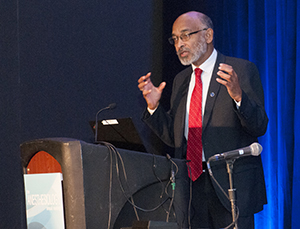
Emery N. Brown, M.D., Ph.D.: ‘There is a close relationship there, but it is not optimally used. I think the future lies in bringing the two together.’
Research on how the brain works is the realm of anesthesiologists and neuroscientists who often interact but do not work together to share their knowledge. Renowned anesthesia researcher Emery N. Brown, M.D., Ph.D., wants that to change.
“Anesthesiology has had a close relationship with neuroscience for many years. But we have not used neuroscience optimally to study anesthesia and vice versa. I think the future lies in bringing them together,” said Dr. Brown, who presented the 2017 Lewis H. Wright Memorial Lecture Sunday.
Dr. Brown used clinical vignettes as well as anesthesia and neurological research to explain some unusual anesthetic reactions, how the brain works and where the work of the two specialties overlaps. He is the Warren M. Zapol Professor of Anaesthesia at Massachusetts General Hospital and Harvard Medical School. He also is the Edward Hood Taplin Professor of Medical Engineering and Professor of Computational Neuroscience at the Massachusetts Institute of Technology
“We often say we don’t understand how the drugs work. One of the things I want to suggest is that nothing could be further from the truth,” Dr. Brown said. “All we have to do is really focus on the neuroscience of what we are doing when we get tremendous, very obvious insight into how the drugs are working.”
He reviewed older visual experiments by neurologists in which cats and monkeys were anesthetized to study their responses. Even research conducted in 2014 combined ketamine with dexmedetomidine to approximate sleep.
“In case you didn’t know it, anesthesia is the accepted model for slow-wave sleep,” Dr. Brown said, drawing laughs from the audience. “Obviously there is not this connection going back and forth between us and them to educate them about what they want to do, and probably vice versa.”
Case vignettes were used to explore neuroleptic anesthesia and Parkinson’s disease. In these cases, patients and the newborn child of a patient experienced chest wall rigidity and symptoms of Parkinson’s disease. These symptoms subsided within hours and were likely due to the dopamine antagonist effect of droperidol, fentanyl and meperidine, he said.
Another example of how the two specialties could learn from one another occurred when Dr. Brown observed an operation and realized the spectrogram of the patient suddenly changed radically. The change occurred when the anesthesia medication transitioned from sevoflurane to nitrous oxide. The change induces deep anesthesia without the stomach upset that can come with using only nitrous oxide. It produces a slow sine wave, but it is a transient state that ends in less than 12 minutes.
Neurological research from 1935 provided insight into separating the brain stem from the brain in cats. This physical separation is similar to the mechanism of anesthesia that blocks arousal pathway, which produce the same large oscillations seen in the switch from sevoflurane to nitrous oxide.
“This has practical clinical applications,” Dr. Brown said. “The patient goes deep for a bit, and it is not going to last. It has helped us out. It has been our friend and we didn’t even know it.”
Another area where the two specialties could cooperate is in burst suppression, which is a low-energy state often induced for medical comas. It is being used more in regular operations, and there may be problems for some patients in those situations, he said.
“They are more likely to become delirious and perhaps go on to have cognitive dysfunction,” Dr. Brown said. “I can argue that we won’t understand any of that unless we get down to the neuroscience of how this process is being produced.”
There are still other examples of how the two groups could learn more from one another, he said. For example, ketamine is increasingly being used as a therapy for depression and has long been used to treat schizophrenia.
“There are these fascinating neuroscience questions that we can offer insight into that are unique for us,” Dr. Brown said. “If we were able to start answering them, then the information flow between … neuroscience and anesthesiology would be a much richer and informative exchange not only for us, but for them as well.
“There is a close relationship there, but it is not optimally used. I think the future lies in bringing the two together.”
Return to Archive Index
